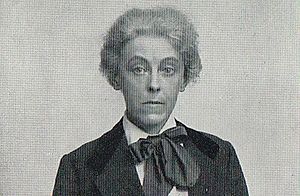Charlotte Mew facts for kids
Quick facts for kids
Charlotte Mew
|
|
|---|---|

Charlotte Mew in 1900
|
|
| Born |
Charlotte Mary Mew
15 November 1869 Bloomsbury, London, England
|
| Died | 24 March 1928 (aged 58) Westminster, England, United Kingdom
|
| Occupation | Writer |
|
Notable work
|
The Farmer's Bride (1916), The Rambling Sailor (1929) |
Charlotte Mary Mew (born November 15, 1869 – died March 24, 1928) was an English poet. Her writing connects the styles of the Victorian era with the newer Modernism. She is known for her unique voice and powerful poems.
Early Life and School

Charlotte Mew was born in Bloomsbury, London. Her father, Frederick Mew, was an architect. He designed important buildings like Hampstead Town Hall. Her mother was Anna Maria Marden. Charlotte was one of seven children.
Charlotte, nicknamed Lotti, went to Gower Street School. Her headmistress, Lucy Harrison, greatly influenced her. Charlotte also attended lectures at University College London.
Her family faced difficult times financially. In 1898, her father passed away. He did not leave enough money for his family. Two of her siblings faced serious health challenges. Three others died when they were very young. This left Charlotte, her mother, and her sister Anne.
Charlotte and Anne decided not to marry. They made this choice because of family health concerns. Charlotte had a strong sense of style. She liked wearing special red stockings in winter. She also bought her small black boots from a fancy shop. Later in life, she sometimes dressed in a more masculine way. She had a unique and noticeable appearance.
Writing Career
In 1894, Charlotte Mew had a short story published. It appeared in a famous magazine called The Yellow Book. The story was about a woman who saw social problems. It showed how these problems affected her deeply.
After five years, she started publishing more often. By the early 1900s, she wrote fiction for magazines like Temple Bar. She began writing most of her poetry around the 1910s.
Her first poetry book, The Farmer's Bride, came out in 1916. It was a small book called a chapbook. In the United States, this collection was named Saturday Market. It was published in 1921. Many famous writers admired her work. These included Ezra Pound, Sara Teasdale, and Virginia Woolf.
Her poems are very different from each other. Some poems, like "Madeleine in Church," explore ideas about faith. Others, like "In Nunhead Cemetery," show a modern style. She used long, prose-like lines in her poems. She also experimented with how lines flowed into each other. This made her writing very original.
Many of her poems are like dramatic monologues. This means a character speaks directly to the reader. She often wrote from the point of view of a male character. Two of her poems, "Ken" and "On the Asylum Road," talk about difficult health situations. Many of her poems are about characters who feel different or alone. This showed Charlotte's own feelings of not quite fitting in. Her poem "The Trees Are Down" is a strong message about caring for nature.
Charlotte Mew gained support from many literary figures. Thomas Hardy called her the best woman poet of her time. Virginia Woolf said she was "very good and interesting." Siegfried Sassoon also admired her. In 1923, she received a special yearly payment. This was called a Civil List pension. It helped her with her financial struggles.
Later Life and Passing
Even with her success, Charlotte Mew did not earn much money. It was hard to support herself, her mother, and her sister. In 1916, their home was declared unsafe.
After her sister passed away in 1927, Charlotte continued to live in Charlotte Street, Fitzroy Square. After Charlotte Mew's death, her friend Alida Monro collected her poems. These were published in 1929 as The Rambling Sailor.
Charlotte Mew is buried in the northern part of Hampstead Cemetery in London.
Images for kids


